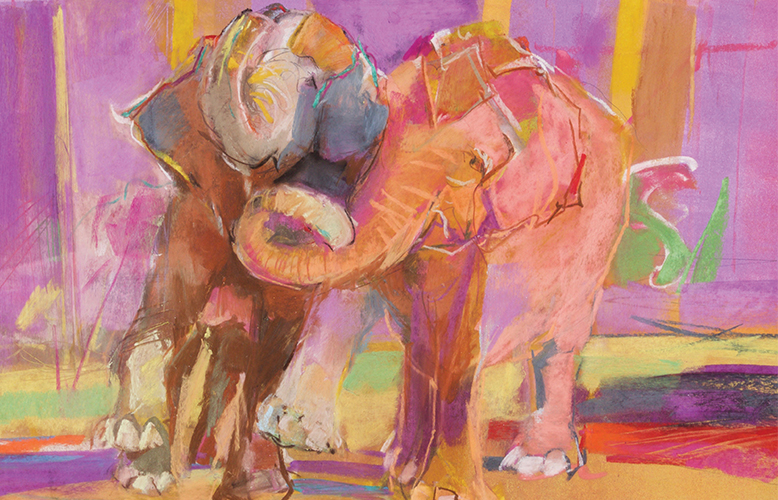(Photo above courtesy of Bend Art Center)
Bend Art Center explored the end of an era with an exhibit by Dawn Emerson.
Last fall, Bend Art Center opened a special exhibit, Cirque d’ Art, a memory-infused series of mixed-media prints by local artist Dawn Emerson. Utilizing both its exhibition area and print studio, Bend Art Center offered a densely-packed schedule of workshops, talks and school programs during the exhibit’s two-month run. A bittersweet memory of magic lost, the Cirque d’ Art exhibit and programs had both young and old talking about the circus.
The Inspiration for Cirque d’ Art
In January 2017, America reverberated with the news that the iconic Ringling Bros. and Barnum & Bailey circus was set to close. Terrebonne artist Dawn Emerson was deeply saddened by the news. “The circus could make you see and feel like a child again,” she reminisced.
Emerson was flooded with memories of her visits to the circus as a child and as an adult. For a brief period in her twenties, she dared to do what most kids in her generation only dreamed of doing: she joined a circus and performed in a synchronized swimming act.
Emerson had toyed with some circus imagery in prior years, but now it became a singular focus. By the time Ringling Bros. held its final show on May 21, Emerson had created close to thirty pieces that would become the Cirque d’ Art exhibit.
The circus proved to be fertile creative ground for Emerson as she worked through ideas related to balancing acts, the act of performing and the role of the ringmaster. The element of danger and risk taking — and the idea of “operating without a net” — resonated with Emerson. “The circus was a place where kids and adults could vicariously project themselves onto a high wire or into the mouth of a lion,” she recalled. “We could taste the danger without actually putting ourselves at risk.”
In Cirque d’ Art, Emerson conjured up the dark forms of lions and tigers, feathered horses and dancing elephants in her signature expressionistic style. As she mined the theme, her work underwent stylistic shifts, tilting into abstraction with simple cutouts of acrobats tumbling through fields of pattern and color. Even more abstract, Emerson’s views of the empty big top communicated a range of emotions — excitement, anticipation, loss.
The Artist’s Process
A consummate pastel artist, Emerson discovered printmaking at Atelier 6000 / A6 (now housed in Bend Art Center). Over the years, she has found ways to pull pastel and printmaking together, combining layers of ink and pastel with a deft hand and eye. Her unique methods are detailed in her new book, Pastel Innovations, published by North Light Books.
Most of the pieces in Cirque d’ Art began as monotype prints. “Monotype allows me to rough out the composition with large fields of color and also create interesting base textures,” Emerson explains. The monotype process is quick and rewarding. Emerson brushes, rolls and manipulates different colors of ink on a smooth plexiglass plate. Once printed on to paper, the print is enhanced with sweeps of colorful loose powdered pastel. Emerson uses pencil and stick pastel to tease out line and detail.
Cirque d’ Art Programs
During the Cirque exhibit, Bend Art Center hosted a variety of workshops, events and talks. Emerson drew an interested audience to her Art Talk, and taught a two-day monotype workshop to artists eager to learn her techniques.
For this key exhibit, Bend Art Center planned a Gallery+Studio arts education program for local schools. During the planning phase, Emerson freely shared her know-how and artist’s tricks to fashion a memorable studio experience for students. Bend Art Center welcomed hundreds of elementary students from across the region to visit the Cirque d’ Art exhibit and then try some of the artist’s techniques. Layering pastel, ink and more pastel (and wielding a giant roller!), kids created colorfully-patterned performers and animals. These figures were used to form a large collaborative circus scene back at school.
During their visit, students also got a serious dose of art history with a look at influential artists who were also inspired by the circus — including Degas, Renoir, Seurat and Toulouse-Lautrec.
Thanks to funding from Art on the River and Clabough Foundation, Bend Art Center brought its school program directly to classrooms in La Pine, Redmond, Three Rivers and Prineville. In all, more than 1,000 students took part in this multi-faceted arts education program.
Bend Art Center offered a variety of beginner-level, circus-themed workshops, from Big Top Books to Paper Acrobats, for a variety of ages.
Bend Art Center’s monthly art appreciation series, Cheers to Art! also took a cue from the Cirque exhibit. Art historian Lorna Cahall gave a presentation on circus-loving Marc Chagall for the October 2017 program.
Last but not least, the Cirque d’ Art exhibit sparked a circus-themed fundraiser and costume party. The Big Top Extravaganza raised support for future exhibits, workshops and school programs at Bend Art Center — ensuring the community can enjoy more memorable art in 2018.
Dawn Boone, Education Manager
Bend Art Center
541-330-8759
550 SW Industrial Way, Suite 180, Bend
bendartcenter.org

